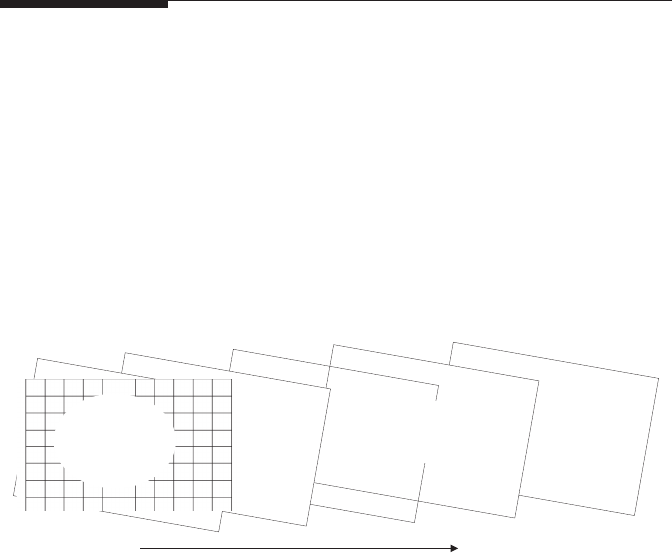
111
6
Digital Video Compression
6.1 Introduction
Considerable research has been conducted in digital video coding technol-
ogy over the last decade. Due to the growing availability of digital transmis-
sion links, progress in signal processing, very large-scale integration (VLSI)
technology, and research in image/video compression, visual communica-
tions has become more viable than ever before. The driving force for the
additional evolution of research in digital video coding is the wide range of
applications such as video on demand, digital TV/HDTV broadcasting, and
multimedia image/video database services.
Signicant benets achieved by video compression are that it offers an ef-
cient and robust way to store or transmit the huge amount of data required
to represent digital video. It also allows more effective use of transmission
and storage resources.
The main goal of video coding is to reduce the average number of bits
needed to represent a video sequence without affecting the video quality.
A significant amount of redundancy subsists between successive
frames of video sequences. The redundancy that exists within frames is
the spatial redundancy, and redundancy that exists between frames is
the temporal redundancy. Video compression is achieved by exploit-
ing these redundancies. The amount of redundancy contained in the
image data and the actual compression techniques used for video cod-
ing greatly influence the performance of video compression techniques.
Video compression can be categorized as lossless or lossy compression,
which mostly depends on the application requirement. The objective of
the lossless video coding is to reduce video data for storage and transmis-
sion while retaining the quality of the original video.
Medical imaging and satellite imaging are examples of lossless applica-
tions where transmission or storage of the highest-quality images is required.
As compared to lossless video coding, the goal of lossy video coding is to
reduce the bit rate for storage and transmission. High video compression is
achieved by degrading the video quality. The compression ratio depends on

112 Image and Video Compression
the target bit rate of the channel. High compression is the requirement of the
smaller target bit rate of the channel.
Temporal and spatial redundancies exist within video sequences.
Interelement correlation is the basic statistical property of the image
sequence including the assumption of simple correlated translatory motion
between consecutive frames. The intraframe coding technique is one in
which the magnitude of a particular image pixel can be predicted from a
nearby pixel within the same frame, whereas in the interframe coding tech-
nique it is predicted from nearby frames. An exploration of a proper method
to exploit the temporal redundancy completely changes the scenario between
compression of still pictures and sequence of images. These methods are
the foundation for very high performances in image sequence coding when
compared to still image coding. Motion estimation and compensation tech-
niques have shown their efciency to reduce the temporal redundancy in
this respect.
6.2 Digital Video Data
A video stream is continuous in both spatial and temporal domains. Spatial
and temporal sampling of the video stream represents the digital video data.
This sampled version of video data is shown in Figure6.1. An image sam-
pled in the spatial domain is typically represented on a rectangular grid. A
temporally sampled video stream is represented as a series of still images
sampled at a regular interval of time. These still images are called frames.
The spatiotemporal sample value termed pixel is represented as a positive
digital number that describes the brightness (luminance) in case of a mono-
chromatic image and color components in case of a color image.
ree-dimensional
video sequence
Two-
dimensional
spatial domain
Temporal Domain
FIGURE 6.1
Three-dimensional video sequence.
Get Image and Video Compression now with the O’Reilly learning platform.
O’Reilly members experience books, live events, courses curated by job role, and more from O’Reilly and nearly 200 top publishers.

